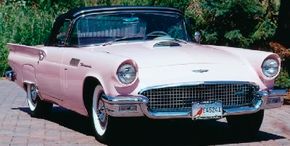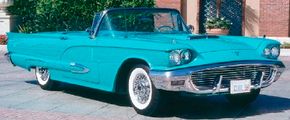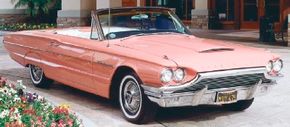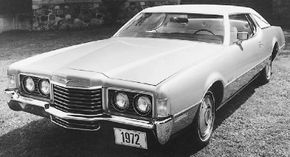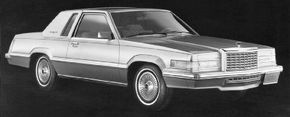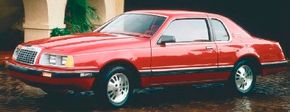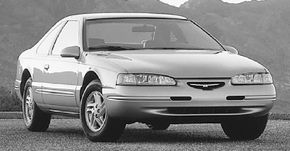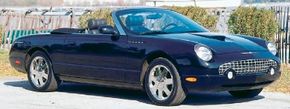Legend says the Thunderbird was born in October 1951, when Ford Division general manager Louis Crusoe visited the Paris Auto Show with styling consultant George Walker. America had a love affair with European sports cars in the early postwar years, and both men were taken by what they saw in Paris -- especially the curvy Jaguar XK-120 and GM's experimental two-seat LeSabre. "Why don't we have something like that?" Crusoe asked. "Oh, but we do!" replied Walker -- who then hurried to phone Dearborn to get his troops cracking.
But like many apocryphal stories, this one isn't true. Frank Hershey, who headed the team that styled the original '55 T-Bird, said Ford had been conjuring two-seaters well before this, but never felt rushed to build one because sports-car sales only amounted to a minuscule 0.27 percent of the total U.S. market.
Advertisement
But in January 1953, GM threw down a gauntlet Ford couldn't ignore: the Chevrolet Corvette. Barely a month later, Ford was hard at work on the car that would ultimately be named for the god worshiped by America's Southwest Native Americans as the bringer of rain and prosperity.First displayed as a wood mock-up at the Detroit show in early 1954, the Thunderbird was a "personal" car, not a pure sports car.
It rode the same wheelbase as the first-generation Corvette -- 102 inches -- but was far more luxurious and practical. In place of creaking fiberglass and clumsy side curtains was a sturdy steel body with convenient roll-up windows.
Instead of an ill-fitting soft top was a snug convertible top, a detachable hardtop, or both. And there was no plodding six-cylinder engine but a burly 292-cubic-inch Mercury V-8 delivering 193 bhp with stickshift or 198 bhp with optional self-shift Ford-O-Matic.
Bill Burnett supervised the engineering, which relied heavily on passenger-Ford components. Styling, conceived by Walker lieutenant Hershey and executed by a young Bill Boyer, couldn't have been better: simple and smooth yet clearly Ford, with rakish long-hood/short-deck proportions recalling the classic early-'40s Lincoln Continental.
With European style and American comfort, convenience, and go, the Thunderbird proved well-nigh irresistible at just under $3000 without options. It whipped the rival Chevy in 1955 production by nearly 24-to-1 -- 16,155 for the model year.
You don't mess with success in Detroit, and Ford didn't with the '56 T-Bird. Changes were limited to a larger 312 V-8 option with 215/225 bhp (nonoverdrive stickshift cars retained the 292, now up to 202 bhp), plus exterior-mounted spare (answering cries for more trunk space), softer suspension (for a smoother ride), and no-cost portholes for the hardtop (a Boyer idea inspired by vintage coachwork).
Porthole hardtops heavily outsold the nonporthole kind in 1956, and virtually all '57 Thunderbirds had them. Production eased to 15,631, but was still five times Corvette's. Trouble was, Robert S. McNamara, who'd replaced Crusoe as head of Ford Division, wanted much higher volume. Also, market surveys indicated much greater demand for a four-seater. So for 1958 and beyond, that's what the T-Bird would be.
The '57 was thus the last two-seat T-Bird -- and arguably the best. A handsome facelift brought a prominent bumper/grille and a longer deck (again enclosing the spare) wearing modest bladelike tailfins. There was more power than ever.
Stickshift models still had a 292, but uprated to 212 bhp, and there was now a trio of 312s offering 245, 270, or 285 bhp, the last being a twin-four-barrel version with 10.0:1 compression. Ford also built 208 supercharged "F-Birds" with 300/340 bhp courtesy of Paxton-McCulloch blowers, mainly for racing.
And race the early T-Birds did, though with limited success. A '55 sponsored by Mechanix Illustrated magazine's Tom McCahill swept the production sports-car class at that year's Daytona Speed Weeks, Joe Ferguson clocking a two-way average of 124.633 mph to best every Austin-Healey, Porsche, and all but one Jaguar XK-120.
Chuck Daigh did even better in '56 with a T-Bird prepped by Pete DePaolo; he did 88.779 mph in the standing mile, though a 'Vette modified by Zora Arkus-Duntov proved faster (at 89.735 mph). Daigh returned in '57 to score 93.312 mph, and a privately entered T-Bird ran the flying-mile at 146.282 mph one way, 138.775 mph both ways. Then the Automobile Manufacturers Association issued its infamous racing "ban" and development stopped.
With a base price still under $3500 for 1957, the T-Bird remained an attractive buy. Production ran through the end of the calendar year, so production was the highest for the three two-seater years at 21,380.
Advertisement
